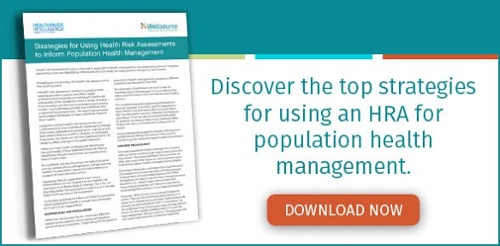Health Risk Assessments (HRAs) are excellent tools for helping your population manage their health, but they’re only one piece of the puzzle. While the HRA results will let individuals learn their risks, the wellness initiatives and programming you provide are the next steps in taking control of their health status.
 To create a strong wellness program, you’ll need useful information from your population. Creating and delivering the assessment won’t do any good if you can’t get your population to buy into the process. And if they aren’t buying in, you won’t have any measurable metrics to make recommendations for interventions and resources.
To create a strong wellness program, you’ll need useful information from your population. Creating and delivering the assessment won’t do any good if you can’t get your population to buy into the process. And if they aren’t buying in, you won’t have any measurable metrics to make recommendations for interventions and resources.
Here are three strategies to keep in mind as you roll out your HRA to help develop your wellness initiatives.
Understand Your Population
When it comes to developing wellness initiatives it’s imperative that you truly understand your population and can demonstrate this understanding by ensuring all the tools and resources you provide—including the HRA—are tailored to their specific needs. For example, both Medicare and Medicaid HRAs are bound by federal regulations to ask specific questions relevant to those populations, such as food access or the ability to independently complete daily tasks. While not a legal requirement, HRAs for the workforce should inquire about an employer’s wellness culture and measure productivity.
You must understand what communication and HRA delivery methods will resonate with your population. Digital HRAs are convenient for most people, except for perhaps some Medicare members. Technology use declines with age. No matter what delivery method you use, be sure your HRA accommodates language, literacy, and assistive technology needs.
Encourage Participation
Population buy-in is a critical component in providing useful resources and interventions from your HRA analysis. If only a handful of your population is willing to complete the HRA and provide you with data, then your results will likely be skewed. Those individuals—the ones who are ready and willing to jump in from the start—aren’t likely the ones who need to be convinced to make lifestyle changes. They already care. Encouraging your population to participate can give you a well-rounded dataset to build your wellness initiatives. Trust is an essential prerequisite of participation. Be sure to use an HRA that uses strict security and privacy practices—and make sure your population understands that their information will be handled confidentially. This will give individuals confidence to answer sensitive questions honestly. Creating a culture of trust to boost health and wellness engagement takes time, but will pay off in dividends.
Meet Your Population’s Needs
You’ll be able to tailor your wellness initiatives to your population’s unique needs and interests based on their results. For example, if you find that most of your population leads a sedentary lifestyle and is high-risk for developing diabetes, then you may logically want to provide resources and interventions that focus on getting more exercise—but be sure to check their change readiness. Recommending they join a 5k training program isn’t likely to be received well unless a large portion of your group is ready to be more active. It’s important to provide resources and interventions that will be embraced by your population and meet them where they are in their wellness journey. This will lead to a positive return on your investment.
To learn more about the various strategies you can use to inform population health management, download Strategies for Using Health Risk Assessments to Inform Population Health Management, below.








